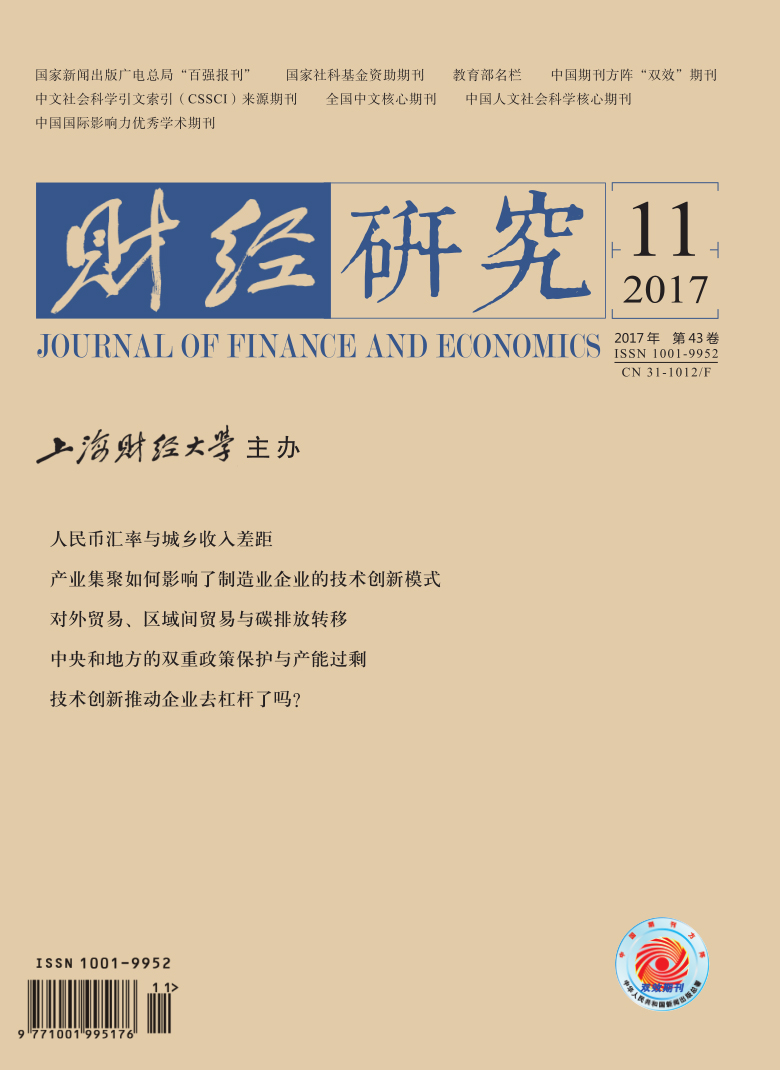创新驱动已成为新常态下培育经济增长新动能、优化经济结构的关键。然而,技术创新通过怎样的路径影响微观结构调整,至今未得到系统性解答。文章研究了技术创新对企业去杠杆的作用。从影响机理看,技术创新通过强化企业市场竞争能力和调整成本对冲能力来调节企业杠杆水平,且该调节作用对过度杠杆企业表现为去杠杆效应,对杠杆不足企业表现为补杠杆效应。从加速机制看,一方面,政府补贴与税收优惠对技术创新产生激励作用,从而对杠杆率调整具有"加速"效应,且加速程度对不同所有制性质和不同成长能力的企业具有异质性;另一方面,行业整体的探索性创新和开发性创新水平越高,知识溢出效应越强,越有助于推动企业技术创新,因此行业创新水平能够显著加速企业去杠杆进程,且探索性创新的加速效应更强。文章证明了技术创新在去杠杆进程中的作用,揭示了政策激励、行业溢出等创新驱动因素对去杠杆的加速作用,丰富了创新驱动战略的微观财务学内涵。
技术创新推动企业去杠杆了吗?——影响机理与加速机制
摘要
参考文献
4 郭炬, 叶阿忠, 陈泓.是财政补贴还是税收优惠?——政府政策对技术创新的影响[J].科技管理研究, 2015, (17):25-31. DOI:10.3969/j.issn.1000-7695.2015.17.005
9 刘啟仁, 黄建忠.产业创新如何影响企业加成率[J].世界经济, 2016, (11):28-53.
10 栾强, 罗守贵.R&D资助、企业创新和技术进步——基于国有企业与民营企业对比的实证研究[J].科学学研究, 2017, (4):625-632.
11 马建堂, 董小君, 时红秀, 等.中国的杠杆率与系统性金融风险防范[J].财贸经济, 2016, (1):5-21.
15 孙璞, 尹小平.政府科技补贴能通过企业科技创新改善产能过剩吗?——基于新能源产业与汽车产业对比研究[J].华东经济管理, 2016, (10):101-106. DOI:10.3969/j.issn.1007-5097.2016.10.016
16 王长勇.创新驱动与财税激励调整[J].清华管理评论, 2017, (1):51-57.
18 威廉·鲍莫尔.创新:经济增长的奇迹[M].北京:中信出版社, 2016.
19 夏力, 李舒妤.政治关联视角下的政府补贴与民营企业技术创新[J].科技进步与对策, 2013, (3):108-111. DOI:10.6049/kjjbydc.2012070642
20 解维敏, 唐清泉, 陆姗姗.政府R&D资助、企业R&D支出与自主创新——来自中国上市公司的经验证据[J].金融研究, 2009, (6):86-99.
23 袁建国, 范文林, 程晨.税收优惠与企业技术创新——基于中国上市公司的实证研究[J].税务研究, 2016, (10):28-33.
25 Almeida H, Campello M. Financial constraints, asset tangibility, and corporate investment[J]. Review of Financial Studies, 2007, 20(5):1429-1460. DOI:10.1093/rfs/hhm019
26 Benner M J, Tushman M I.Exploitation, exploration and process management:The productivity dilemma revisited[J]. Academy of Management Review, 2003, 28(2):238-256.
27 Brander J, Lewis T. Oligopoly and financial structure:The limited liability effect[J]. American Economic Review, 1986, 76(5):956-970.
28 Chirinko R S. Business fixed investment spending:Modeling strategies, empirical results, and policy implications[J]. Journal of Economic Literature, 1993, 31(4):1875-1911.
29 Faulkender M W, Flannery M J, Hankins K W, et al. Do adjustment costs impeding realization of target capital structure?[R]. SSRN Working Paper No.972148, 2007.
30 Flannery M, Rangan K. Partial adjustment toward target capital structures[J]. Journal of Financial Economics, 2006, 79(3):469-506. DOI:10.1016/j.jfineco.2005.03.004
31 Hall B H, Mairesse J, Mohnen P. Measuring the returns to R&D[A]. Hall B, Rosenberg N. Handbook of the economics of innovation[C]. Amsterdam and Oxford:North-Holland, 2010.
32 Laursen K, Salter A. Open for innovation:The role of openness in explaining innovation performance among U.K. manufacturing firms[J]. Strategic Management Journal, 2006, 27(2):131-150. DOI:10.1002/(ISSN)1097-0266
33 Showaher D. Oligopoly and financial structure:Comment[J]. American Economic Review, 1995, 85(3):647-654.
34 Takalo T, Tanayama T. Adverse selection and financing of innovation:Is there a need for R&D subsidies[J]. Journal of Technology Transfer, 2010, 35(1):16-41. DOI:10.1007/s10961-009-9112-8
35 Tsoy L, Heshmati A. Impact of financial crises on dynamics of capital structure:Evidence from Korean listed companies[R]. IZA Discussion Paper No.10554, 2017.
36 Xia T, Roper S. Unpacking open innovation:Absorptive capacity, exploratory and exploitative openness, and the growth of entrepreneurial biopharmaceutical firms[J]. Journal of Small Business Management, 2016, 54(3):931-952. DOI:10.1111/jsbm.2016.54.issue-3
引用本文
于博. 技术创新推动企业去杠杆了吗?——影响机理与加速机制[J]. 财经研究, 2017, 43(11): 113–127.
导出参考文献,格式为:





 9875
9875  5888
5888

